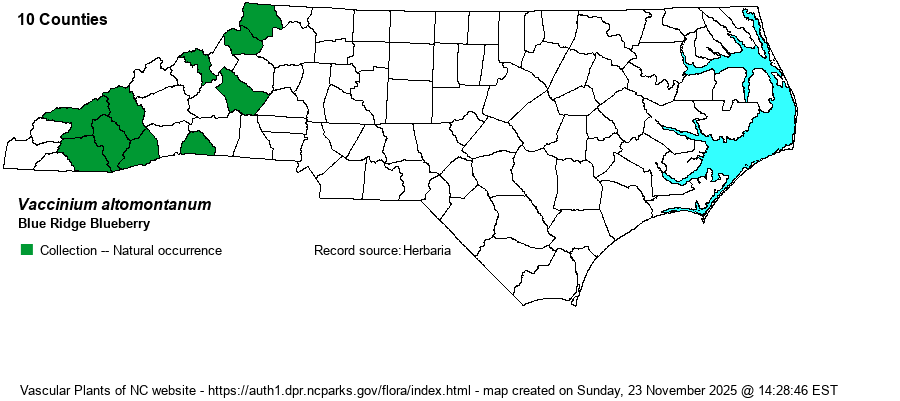| Section 6 » Family Ericaceae |
Show/Hide Synonym
| taxonName | relationship | relatedTaxonName | relatedTaxonRefText | relComments |
|---|
|
| Vaccinium altomontanum | = | Vaccinium alto-montanum | Gleason (1952) | , orthographic variant | | Vaccinium altomontanum | = | Vaccinium alto-montanum | Stevens et al. in Kubitzki (2004). Key based in part on Uttal (1987). | , orthographic variant | | Vaccinium altomontanum | < | Vaccinium pallidum | Flora of North America (1993b, 1997, 2000, 2002a, 2002b, 2003a, 2004b, 2005, 2006a, 2006b, 2006c, 2007a, 2009, 2010) | | | Vaccinium altomontanum | < | Vaccinium pallidum | | | | Vaccinium altomontanum | < | Vaccinium pallidum | | | | Vaccinium altomontanum | < | Vaccinium pallidum | | | | Vaccinium altomontanum | < | Vaccinium corymbosum | Radford, Ahles, and Bell (1968) | | | Vaccinium altomontanum | > | Cyanococcus subcordatus | Small (1933, 1938) | | | Vaccinium altomontanum | > | Cyanococcus liparis | Small (1933, 1938) | | | Vaccinium altomontanum | > | Cyanococcus liparis | | | | Source: Weakley's Flora |
|
| Author | Ashe | |
| Distribution | Strictly in the Mountains, and essentially only in the higher elevations, though the exact distribution is rather poorly known. This taxon was described as new in 1931, but lumped under V. pallidum ever since. However, Weakley (2018) and other authors have recently split out this taxon. See Taxonomic Comments.
This is a southern Appalachian endemic, limited to a rather small (but tight) area from western VA south to northwestern SC, and northern GA. It also occurs in eastern TN.
| |
| Abundance | Apparently locally uncommon; not well studied. After more thorough study, might not be scarce in the state, as suitable habitat appears to be rather common. It is not designated as a Watch List species by NCNHP, though perhaps it should, until more information is gathered. Based on Weakley (2020), the editors suggest a Global Rank of G4?; NatureServe does not consider this taxon as valid. | |
| Habitat | This species occurs mainly on exposed ridges and summits, such as shrub balds and the margins of grass balds and outcrops, over acidic soils. It also occurs on ridge crests and acidic side slopes of forests, but seems to grow primarily in full or partial sun. | |
| Phenology | Blooms in May and June, after the leaves have emerged and are mostly fully grown. Fruits from July to September. | |
| Identification | This deciduous shrub looks quite like V. pallidum in that the leaves are quite glaucous (pale and slightly blue-green). However, this species grows somewhat taller, averaging about 3 feet tall instead of 1-2 feet for V. pallidum; also, it grows in denser stands, frequently with interweaving branches and excluding other woody growth. Though V. pallidum often grows in extensive stands, individual shrubs seldom grow close enough to form dense stands. The leaves are somewhat thicker than those of V. pallidum, as well (Weakley 2018). Also, this species seems to favor sites in full sun, whereas V. pallidum characteristically dominates the low shrub zone inside dry/xeric forests. This shrub may not be that scarce in NC, and perhaps is locally common on some mountaintops, but as it is a recent split, few biologists are likely familiar with it, as yet. | |
| Taxonomic Comments | Though the name Vaccinium altomontanum was used many decades ago, the entity has almost always been subsumed within the widespread V. pallidum until recently, when some references (such as Weakley 2018) have split it off from V. pallidum. V. altomontanum may represent a hybrid species – it is a tetraploid and not diploid. Whatever the case, it is a fairly distinctive, densely growing blueberry of high elevation exposed rocky places and is clearly not simply “just a form of V. pallidum”. The main issue hindering its proper taxonomic placement is that the type specimen is apparently lost (pers. comm. Peter Fritsch). Neither NatureServe nor iNaturalist recognize this species (from V. pallidum), which is rather surprising considering how distinctive this taxon is.
| |
| Other Common Name(s) | None (?) as yet | |
| State Rank | S3? | |
| Global Rank | GNR [G4?] | |
| State Status | | |
| US Status | | |
| USACE-agcp | | |
| USACE-emp | | |

